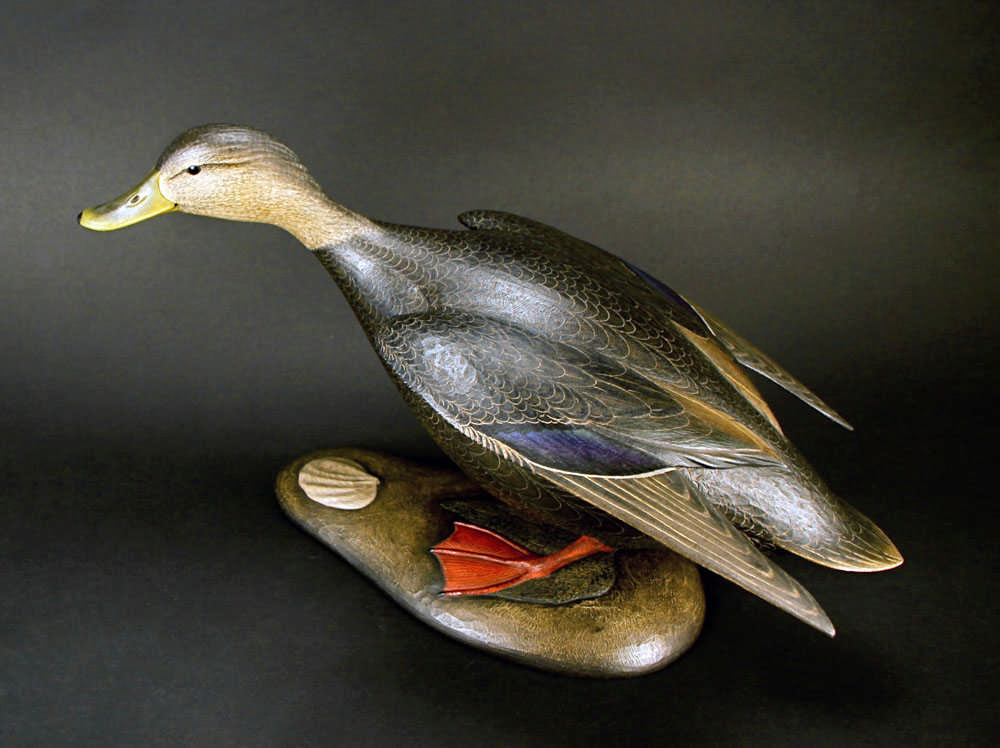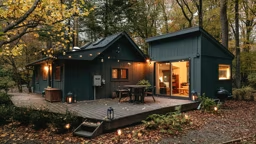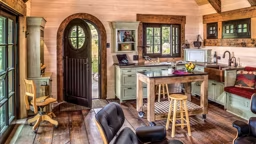ATTEND A DECOY SHOW
A trade show is an excellent place to start your decoy collection, watch carvers at work and attend seminars. Here are some of the largest events:
ILLINOIS
Midwest Decoy Collector’s Show
(This is considered the national show)
St. Charles, Ill.
www.midwestdecoy.org
MARYLAND
Chesapeake Wildfowl Expo
Salisbury, Md.
www.wardmuseum.org
Waterfowl Festival
Easton, Md.
www.waterfowlfestival.org
Havre de Grace Decoy & Wildlife Art Festival
Havre de Grace, Md.
www.decoymuseum.com
MINNESOTA
Minnesota Decoy Show
Bloomington, Minn.
mndecoycollectors.com
OHIO
Ohio Decoy Show
Westlake, Ohio
www.odcca.net
WASHINGTON
Northwest Decoy Show
Bellevue, Wash.
email: nwdecoy@gmail.com
WISCONSIN
Wisconsin Decoy & Sporting Collectibles Show
Oshkosh, Wis.
email: rogfuzz@charter.net
_ _ _ _ _ _ _ _ _ _ _ _ _ _ _ _ _ _ _ _ _ _ _ _
VISIT MUSEUMS
To see some decoys from the nation’s best artists, visit any of these museums. Your local museum may also feature exhibits.
Ward Museum of Wildfowl Art
Salisbury, Md.
(410) 742-4988
www.wardmuseum.org
Havre de Grace Decoy Museum
Havre de Grace, Md.
(410) 939-3739
www.decoymuseum.com
Chesapeake Bay Maritime Museum
St. Michaels, Md.
(410) 745-2916
www.cbmm.org
A trade show is an excellent place to start your decoy collection, watch carvers at work and attend seminars. Here are some of the largest events:
ILLINOIS
Midwest Decoy Collector’s Show
(This is considered the national show)
St. Charles, Ill.
www.midwestdecoy.org
MARYLAND
Chesapeake Wildfowl Expo
Salisbury, Md.
www.wardmuseum.org
Waterfowl Festival
Easton, Md.
www.waterfowlfestival.org
Havre de Grace Decoy & Wildlife Art Festival
Havre de Grace, Md.
www.decoymuseum.com
MINNESOTA
Minnesota Decoy Show
Bloomington, Minn.
mndecoycollectors.com
OHIO
Ohio Decoy Show
Westlake, Ohio
www.odcca.net
WASHINGTON
Northwest Decoy Show
Bellevue, Wash.
email: nwdecoy@gmail.com
WISCONSIN
Wisconsin Decoy & Sporting Collectibles Show
Oshkosh, Wis.
email: rogfuzz@charter.net
_ _ _ _ _ _ _ _ _ _ _ _ _ _ _ _ _ _ _ _ _ _ _ _
VISIT MUSEUMS
To see some decoys from the nation’s best artists, visit any of these museums. Your local museum may also feature exhibits.
Ward Museum of Wildfowl Art
Salisbury, Md.
(410) 742-4988
www.wardmuseum.org
Havre de Grace Decoy Museum
Havre de Grace, Md.
(410) 939-3739
www.decoymuseum.com
Chesapeake Bay Maritime Museum
St. Michaels, Md.
(410) 745-2916
www.cbmm.org
Originally an ingenious tool used by hunters, duck decoys have undoubtedly been enlivening the cabinets, mantels, and nooks in countless getaways for generations.
Decoy evolution
Native American hunters were the first to discover that strategically placed imitation ducks would attract live birds for easier hunting. They fashioned the first decoys from mud, grasses, bulrushes, and even fowl carcasses.
Colonists to the United States adopted the decoy strategy and built on the time-honored techniques. By the mid-19th century, they were carving the decoys out of wood, using little more than a hatchet, axe and knife. Pine and white cedar were most commonly used, due to their durability and buoyancy. Carvers would then sand, prime and paint the decoys in natural colors.
Decoy evolution
Native American hunters were the first to discover that strategically placed imitation ducks would attract live birds for easier hunting. They fashioned the first decoys from mud, grasses, bulrushes, and even fowl carcasses.
Colonists to the United States adopted the decoy strategy and built on the time-honored techniques. By the mid-19th century, they were carving the decoys out of wood, using little more than a hatchet, axe and knife. Pine and white cedar were most commonly used, due to their durability and buoyancy. Carvers would then sand, prime and paint the decoys in natural colors.
Valued art form
Today, decoys are considered collectible folk art, and some vintage pieces are worth six figures or more, depending on their condition. The largest decoy auction firm, Guyette & Schmidt Inc., has totaled more than $132 million in decoy sales since its first auction in 1984.
Generally, a decoy’s value depends the following factors: condition of the paint and wood, rarity, and the reputation of the carver. Condition is often affected by age, but decoys that never suffered hunting damage tend to be more valuable.
Restoration artists can return a decoy to its original form, but heavy-handed work results in a significant decline in value. When it comes to rarity, some species, such as teal and wood ducks, are harder to come by. Some poses, like sleeping and feeding birds, are also less common.
Today, decoys are considered collectible folk art, and some vintage pieces are worth six figures or more, depending on their condition. The largest decoy auction firm, Guyette & Schmidt Inc., has totaled more than $132 million in decoy sales since its first auction in 1984.
Generally, a decoy’s value depends the following factors: condition of the paint and wood, rarity, and the reputation of the carver. Condition is often affected by age, but decoys that never suffered hunting damage tend to be more valuable.
Restoration artists can return a decoy to its original form, but heavy-handed work results in a significant decline in value. When it comes to rarity, some species, such as teal and wood ducks, are harder to come by. Some poses, like sleeping and feeding birds, are also less common.
Starting your collection
Duck decoys can add a touch of authenticity and Americana to your cabin décor, but decoy collecting can seem overwhelming at first. We interviewed some of the world’s most avid collectors and dealers, and they offered this advice for newbie collectors:
Duck decoys can add a touch of authenticity and Americana to your cabin décor, but decoy collecting can seem overwhelming at first. We interviewed some of the world’s most avid collectors and dealers, and they offered this advice for newbie collectors:
- Attend a show. There are many exhibitions of decoys and other sporting collectibles nationwide (scroll down to view a list). These are great places to get your webbed feet wet.
- Do your research. Experts have written many books that will help you become an informed collector. Start with Wildfowl Decoys, written by Joel Barber in 1934.
- Know what you’re looking at. Learn to recognize characteristics that set decoys apart so that you can be a smarter shopper.
- Narrow your target. Focus on the carving style, region, species or artist that appeals to you most. If you shop with a clear game plan, the available variety will be less overwhelming.
- Attend an auction. The largest auctions are hosted by Guyette & Schmidt Inc. and Ducks Unlimited Inc.
- Ask a lot of questions. There are many experts and experienced collectors who are willing to offer advice.
To read more about the decoy carvers we talked to and see more of their art, click here.
By the time the Civil War began, decoy carving had become nearly an art form as people began to recognize the talent of the men and women who specialized in decoy carving. An increase in wealthy sport hunters, who wanted decoys that were both beautiful and useful, led some carvers to start making purely decorative pieces.
Through the years, the style and species of decoys have varied by region and the carver’s preferences. Within regions, decoys could take a number of forms as well. Some were built to float (hollow or solid construction), while others, called “stickups,” were made to be stationary on land.
Regulation of commercial hunting in the 1920s led to a huge decline in demand for decoys. The mass-production of cheaper and lighter plastic decoys began in the 1950s, making wooden decoys even scarcer.
Through the years, the style and species of decoys have varied by region and the carver’s preferences. Within regions, decoys could take a number of forms as well. Some were built to float (hollow or solid construction), while others, called “stickups,” were made to be stationary on land.
Regulation of commercial hunting in the 1920s led to a huge decline in demand for decoys. The mass-production of cheaper and lighter plastic decoys began in the 1950s, making wooden decoys even scarcer.
Revered artisans
While there have been thousands of decoy carvers throughout history, some have become celebrated for their work. Elmer Crowell (1862–1952), a master carver from Cape Cod, was most famous for his decoys with carved wings, glass eyes and detailed head and breast feathers he fashioned with a rasp.
Brothers Lem and Steve Ward of Maryland carved decoys for more than 50 years, producing about 25,000 decoys in the 20th century. The Ward Museum of Wildfowl Art was established in 1975 to preserve the legacy of the Ward Brothers, whose work is now renowned among collectors.
With increasing demand from collectors, there has been a reemergence of contemporary artists. Some carve in the tradition of the first craftsmen, using simple lines and blockish paint patterns. Others produce extremely detailed, lifelike decoys. Traditional designs tend to fetch more on the auction block, but, in the end, it’s the individual collector’s personal tastes that determine value.
While there have been thousands of decoy carvers throughout history, some have become celebrated for their work. Elmer Crowell (1862–1952), a master carver from Cape Cod, was most famous for his decoys with carved wings, glass eyes and detailed head and breast feathers he fashioned with a rasp.
Brothers Lem and Steve Ward of Maryland carved decoys for more than 50 years, producing about 25,000 decoys in the 20th century. The Ward Museum of Wildfowl Art was established in 1975 to preserve the legacy of the Ward Brothers, whose work is now renowned among collectors.
With increasing demand from collectors, there has been a reemergence of contemporary artists. Some carve in the tradition of the first craftsmen, using simple lines and blockish paint patterns. Others produce extremely detailed, lifelike decoys. Traditional designs tend to fetch more on the auction block, but, in the end, it’s the individual collector’s personal tastes that determine value.
















